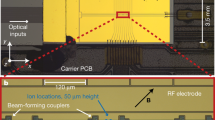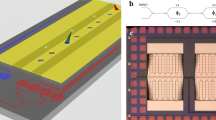Abstract
Monolithic integration of control technologies for atomic systems is a promising route to the development of quantum computers and portable quantum sensors1,2,3,4. Trapped atomic ions form the basis of high-fidelity quantum information processors5,6 and high-accuracy optical clocks7. However, current implementations rely on free-space optics for ion control, which limits their portability and scalability. Here we demonstrate a surface-electrode ion-trap chip8,9 using integrated waveguides and grating couplers, which delivers all the wavelengths of light required for ionization, cooling, coherent operations and quantum state preparation and detection of Sr+ qubits. Laser light from violet to infrared is coupled onto the chip via an optical-fibre array, creating an inherently stable optical path, which we use to demonstrate qubit coherence that is resilient to platform vibrations. This demonstration of CMOS-compatible integrated photonic surface-trap fabrication, robust packaging and enhanced qubit coherence is a key advance in the development of portable trapped-ion quantum sensors and clocks, providing a way towards the complete, individual control of larger numbers of ions in quantum information processing systems.
This is a preview of subscription content, access via your institution
Access options
Access Nature and 54 other Nature Portfolio journals
Get Nature+, our best-value online-access subscription
$29.99 / 30 days
cancel any time
Subscribe to this journal
Receive 51 print issues and online access
$199.00 per year
only $3.90 per issue
Buy this article
- Purchase on Springer Link
- Instant access to full article PDF
Prices may be subject to local taxes which are calculated during checkout




Similar content being viewed by others
Data availability
All relevant data are available from the corresponding authors on request.
Change history
19 January 2021
A Correction to this paper has been published: https://doi.org/10.1038/s41586-020-03104-8
References
Mehta, K. K. et al. Integrated optical addressing of an ion qubit. Nat. Nanotechnol. 11, 1066–1070 (2016).
Slichter, D. H. et al. UV-sensitive superconducting nanowire single photon detectors for integration in an ion trap. Opt. Express 25, 8705–8720 (2017).
Todaro, S. L. et al. State readout of a trapped ion qubit using a trap-integrated superconducting photon detector. Preprint at https://arxiv.org/abs/2008.00065 (2020).
Stuart, J. et al. Chip-integrated voltage sources for control of trapped ions. Phys. Rev. Appl. 11, 024010 (2019).
Cirac, J. I. & Zoller, P. Quantum computations with cold trapped ions. Phys. Rev. Lett. 74, 4091–4094 (1995).
Bruzewicz, C. D., Chiaverini, J., McConnell, R. & Sage, J. M. Trapped-ion quantum computing: Progress and challenges. Appl. Phys. Rev. 6, 021314 (2019).
Brewer, S. M. et al. 27Al+ quantum-logic clock with a systematic uncertainty below 10−18. Phys. Rev. Lett. 123, 033201 (2019).
Chiaverini, J. et al. Surface-electrode architecture for ion-trap quantum information processing. Quantum Inf. Comput. 5, 419–439 (2005).
Seidelin, S. et al. Microfabricated surface-electrode ion trap for scalable quantum information processing. Phys. Rev. Lett. 96, 253003 (2006).
Leibfried, D., Blatt, R., Monroe, C. & Wineland, D. Quantum dynamics of single trapped ions. Rev. Mod. Phys. 75, 281–324 (2003).
Monroe, C. & Kim, J. Scaling the ion trap quantum processor. Science 339, 1164–1169 (2013).
Gaebler, J. P. et al. High-fidelity universal gate set for 9Be+ ion qubits. Phys. Rev. Lett. 117, 060505 (2016).
Ballance, C. J., Harty, T. P., Linke, N. M., Sepiol, M. A. & Lucas, D. M. High-fidelity quantum logic gates using trapped-ion hyperfine qubits. Phys. Rev. Lett. 117, 060504 (2016).
Nam, Y. et al. Ground-state energy estimation of the water molecule on a trapped-ion quantum computer. npj Quantum Inf. 6, 33 (2020).
Wright, K. et al. Benchmarking an 11-qubit quantum computer. Nat. Commun. 10, 5465 (2019).
Ruster, T. et al. Entanglement-based DC magnetometry with separated ions. Phys. Rev. X 7, 031050 (2017).
Delehaye, M. & Lacrote, C. Single-ion, transportable optical atomic clocks. J. Mod. Opt. 65, 622–639 (2018).
Thom, J., Yuen, B., Wilpers, G., Riis, E. & Sinclair, A. G. Intensity stabilisation of optical pulse sequences for coherent control of laser-driven qubits. Appl. Phys. B 124, 90 (2018).
Dalgoutte, D. G. & Wilkinson, C. D. W. Thin grating couplers for integrated optics: an experimental and theoretical study. Appl. Opt. 14, 2983–2998 (1975).
Sorace-Agaskar, C. et al. Versatile silicon nitride and alumina integrated photonic platforms for the ultraviolet to short-wave infrared. IEEE J. Sel. Top. Quantum Electron. 25, 1–15 (2019).
Almeida, V. R., Panepucci, R. R. & Lipson, M. Nanotaper for compact mode conversion. Opt. Lett. 28, 1302–1304 (2003).
Sage, J. M., Kerman, A. J. & Chiaverini, J. Loading of a surface-electrode ion trap from a remote, precooled source. Phys. Rev. A 86, 013417 (2012).
Wang, S. X. et al. Laser-induced charging of microfabricated ion traps. J. Appl. Phys. 110, 104901 (2011).
Bruzewicz, C. D., McConnell, R., Chiaverini, J. & Sage, J. M. Scalable loading of a two-dimensional trapped-ion array. Nat. Commun. 7, 13005 (2016).
Mehta, K. K. & Ram, R. J. Precise and diffraction-limited waveguide-to-free-space focusing gratings. Sci. Rep. 7, 2019 (2017).
Safronova, U., Safronova, M. & Johnson, W. Forbidden M1 and E2 transitions in monovalent atoms and ions. Phys. Rev. A 95, 042507 (2017).
Mehta, K. K. et al. Integrated optical multi-ion quantum logic. Nature https://www.nature.com/articles/s41586-020-2823-6 (2020).
Mehta, K. K. et al. Ion traps fabricated in a CMOS foundry. Appl. Phys. Lett. 105, 044103 (2014).
Bruzewicz, C. D., Sage, J. M. & Chiaverini, J. Measurement of ion motional heating rates over a range of trap frequencies and temperatures. Phys. Rev. A 91, 041402 (2015).
Bauters, J. F. et al. Ultra-low-loss high-aspect-ratio Si3N4 waveguides. Opt. Express 19, 3163–3174 (2011).
Roos, C. Controlling the Quantum State of Trapped Ions. PhD thesis, Univ. Innsbruck (2000).
West, G. N. et al. Low-loss integrated photonics for the blue and ultraviolet regime. APL Photon. 4, 026101 (2019).
Acknowledgements
We thank P. Murphy, C. Thoummaraj and K. Magoon for assistance with chip packaging, and P. Hassett and K. Yu for chip-facet polishing. This material is based on work supported by the Department of Defense under Air Force Contract number FA8702-15-D-0001. Any opinions, findings, conclusions or recommendations expressed in this material are those of the authors and do not necessarily reflect the views of the Department of Defense.
Author information
Authors and Affiliations
Contributions
J.M.S. and J.C. conceived the work. C.S.-A. and S.B. designed the integrated optical components; D.K. oversaw the fabrication of the devices. R.J.N. performed the experiments, with assistance from J.S., C.D.B., D.R., R.M., R.T.M., G.N.W. and W.L.; R.J.N. analysed the data. All authors discussed the results and contributed to writing the paper.
Corresponding authors
Ethics declarations
Competing interests
The authors declare no competing interests.
Additional information
Peer review information Nature thanks Jungsang Kim and the other, anonymous, reviewer(s) for their contribution to the peer review of this work.
Publisher’s note Springer Nature remains neutral with regard to jurisdictional claims in published maps and institutional affiliations.
Extended data figures and tables
Extended Data Fig. 1 Plan view of one of the grating couplers superimposed on the trap electrode metal (partial).
The single-mode (SM) waveguide is tapered to provide a wider beam at the grating coupler. The grating teeth are formed via a partial etch into the waveguide material beneath a window in the electrode metal. The gratings used are forward-emitting, designed to emit a beam to the ion location as depicted, but 55 μm above the surface of the metal.
Extended Data Fig. 2 Integrated photonic beam profiles measured from camera-recorded images.
a, High-numerical-aperture microscope images of the beams are taken while vertically scanning the focal plane above the chip. b, c, Laser light is emitted from the grating couplers and imaged at a height of z = 0 (b) and z = 25 μm (c) above the ion-trap electrodes.
Extended Data Fig. 3 Ion interaction profile of 408-nm light, which was used as a proxy for 405-nm light.
Error bars indicate the standard error of the mean.
Rights and permissions
About this article
Cite this article
Niffenegger, R.J., Stuart, J., Sorace-Agaskar, C. et al. Integrated multi-wavelength control of an ion qubit. Nature 586, 538–542 (2020). https://doi.org/10.1038/s41586-020-2811-x
Received:
Accepted:
Published:
Issue Date:
DOI: https://doi.org/10.1038/s41586-020-2811-x
This article is cited by
-
Penning micro-trap for quantum computing
Nature (2024)
-
Room-temperature waveguide-coupled silicon single-photon avalanche diodes
npj Nanophotonics (2024)
-
Rapid exchange cooling with trapped ions
Nature Communications (2024)
-
Widely tunable and narrow-linewidth chip-scale lasers from near-ultraviolet to near-infrared wavelengths
Nature Photonics (2023)
-
Photonic integrated beam delivery for a rubidium 3D magneto-optical trap
Nature Communications (2023)
Comments
By submitting a comment you agree to abide by our Terms and Community Guidelines. If you find something abusive or that does not comply with our terms or guidelines please flag it as inappropriate.



